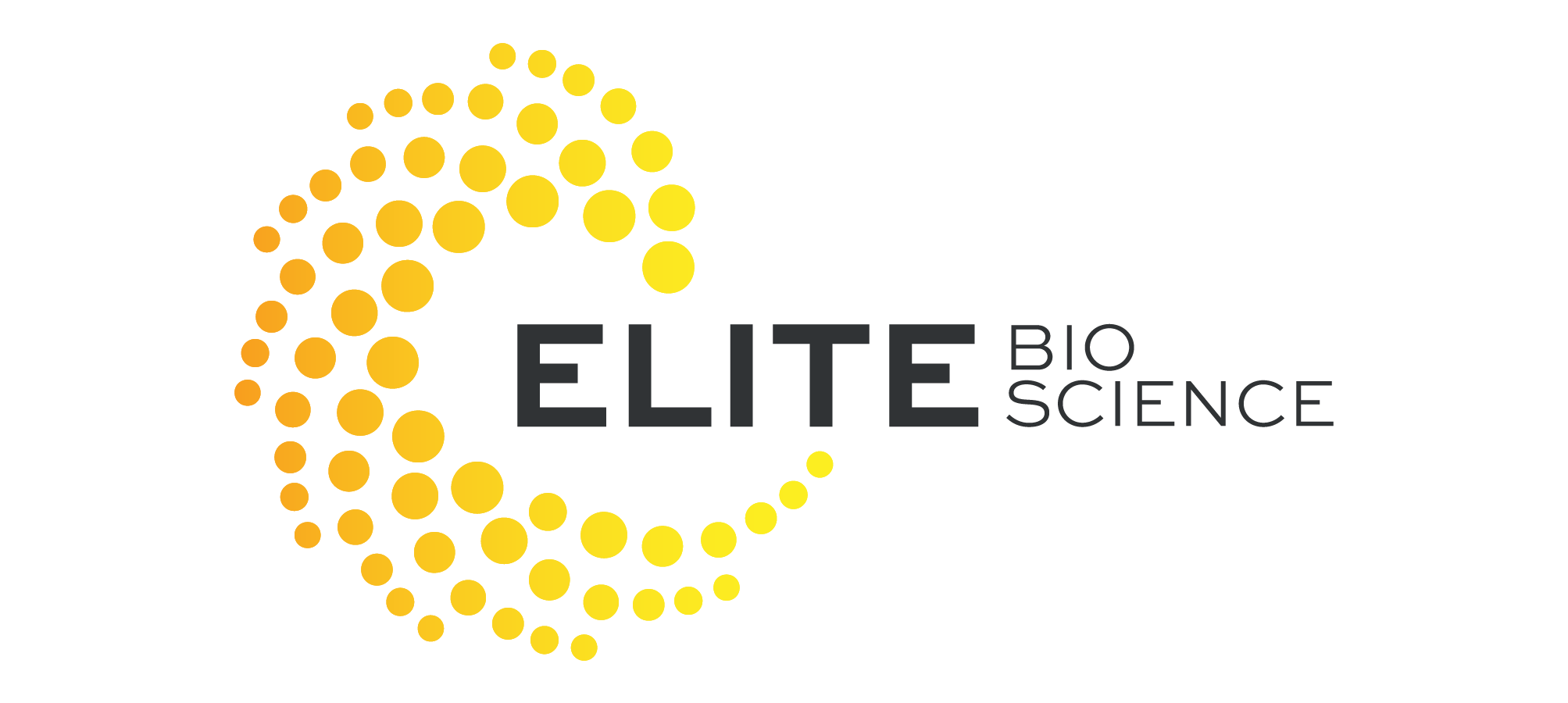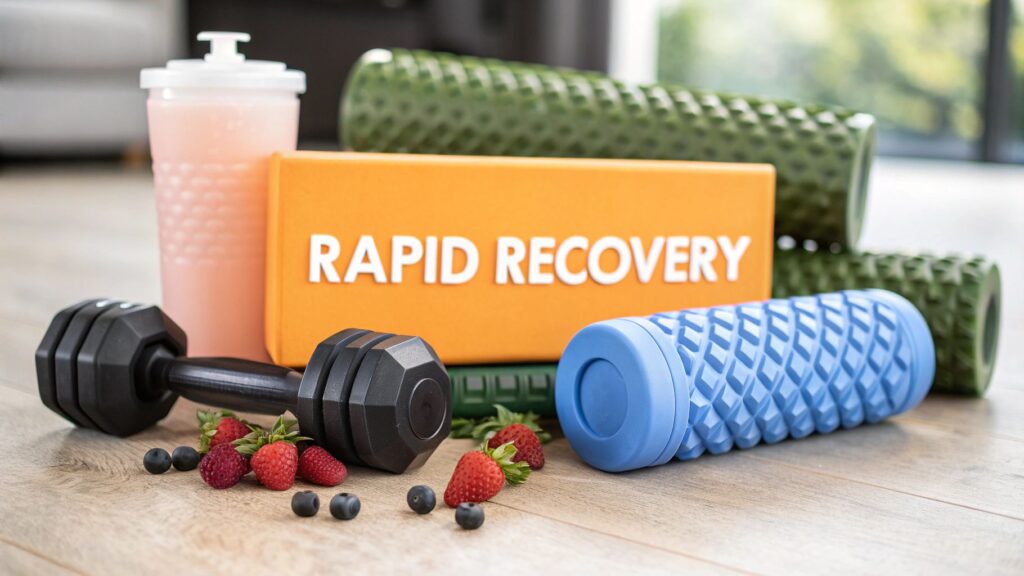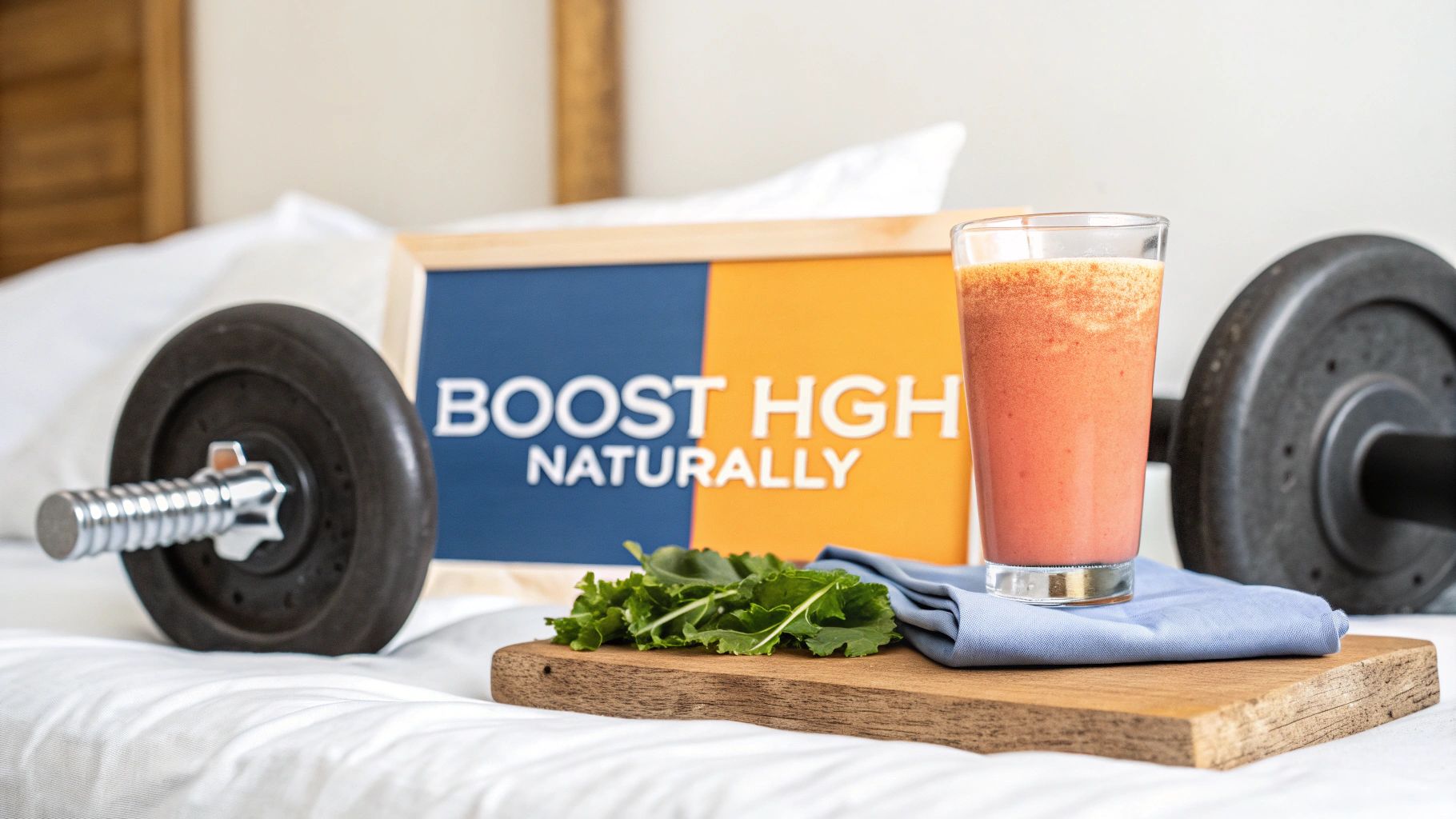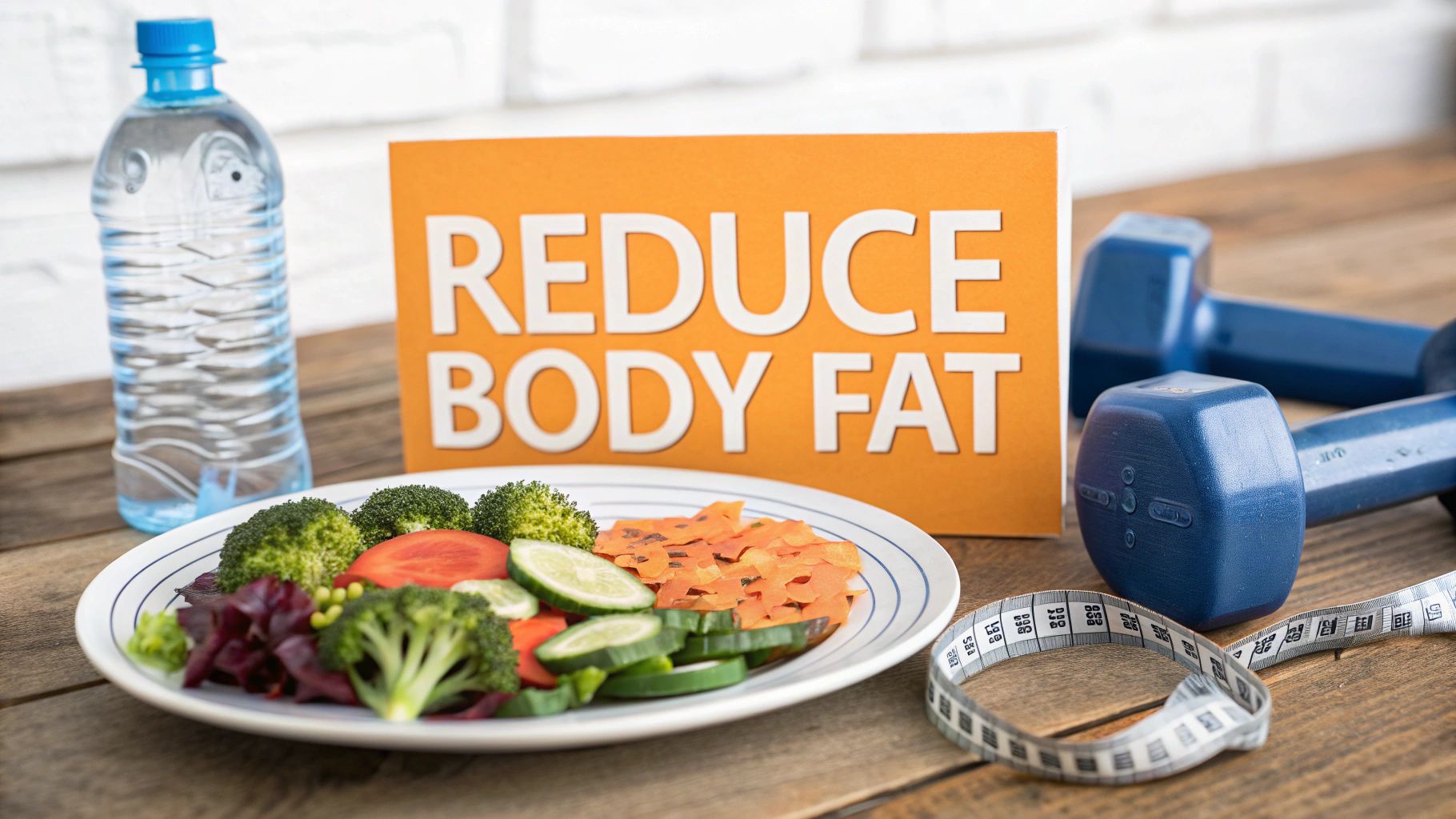To get faster muscle recovery, you need a smart plan. It’s about prioritizing sleep, nutrition, and active recovery over just kicking your feet up and waiting. The biggest wins come from nailing your protein intake right after a workout, getting 7-9 hours of quality sleep, and doing some light movement on your off-days to boost blood flow and ease soreness.
Why Your Recovery Strategy Is Sabotaging Your Gains
Ever crush a workout and feel like you're on top of the world, only to find that walking down a single flight of stairs the next day feels impossible? Yeah, we've all been there.
Many of us wear that deep, aching muscle soreness as a badge of honor, taking it as the only real sign of a good session. But the real magic—the growth, the strength, the actual progress—all happens in the hours and days after you leave the gym. That crucial window is where your body gets to work repairing and rebuilding.
The official term for that post-workout pain is Delayed Onset Muscle Soreness (DOMS). It’s caused by microscopic tears in your muscle fibers, which is a totally normal part of getting stronger. But if you're constantly dealing with debilitating soreness, that’s a major red flag. It’s a clear sign your recovery strategy just isn't cutting it and your body can't keep up.
The Misconception of More Is More
I learned this one the hard way. For years, my mantra was simple: if I wasn't painfully sore, I obviously didn't train hard enough. I’d grind through workouts on pure willpower, completely ignoring the warning signals my body was screaming at me.
The result? My progress stalled, I was tired all the time, and I felt like I was one bad rep away from an injury. My gains hit a wall because I treated recovery as an afterthought instead of a non-negotiable part of my training.
The truth is, your workout only stimulates growth, but your recovery is what actually achieves it. Without a smart plan to repair the damage, you're just breaking your body down over and over without ever giving it the chance to build back stronger.
This shift in mindset is everything. A truly effective approach isn't just about resting—it's about actively supporting your body's natural repair process. Understanding how to improve muscle recovery is the key that unlocks consistent, long-term results. When you finally optimize this phase, you can train harder and more often, and finally smash through those frustrating plateaus.
Fueling Your Recovery from the Inside Out

Think of your body like a high-performance engine. After you push it to the limit, you can't just park it and hope it's ready for the next race. It needs premium fuel to rebuild. Your muscles are no different. What you eat—and just as importantly, when you eat it—is the foundation of a speedy recovery.
You’ve probably heard of the "anabolic window," that critical period after a workout when your muscles are practically begging for nutrients. While we now know it's a bit more flexible than the old 30-minute rule, aiming to refuel within 60-90 minutes is a rock-solid strategy to get the repair process started.
This first post-workout meal isn't just about satisfying hunger. It has two very specific jobs: refilling your muscle glycogen stores (your body's primary fuel source) and delivering the raw materials for tissue repair.
Your Post-Workout Nutrition Blueprint
The perfect recovery meal comes down to a tag team of two macronutrients: protein and carbohydrates. Protein delivers the amino acids needed to patch up those microscopic muscle tears, while carbs are all about restocking your energy tanks. Carbs also help shuttle that protein into your muscle cells more efficiently.
A great rule of thumb is to aim for a carbohydrate-to-protein ratio of about 3:1 or 2:1. For someone weighing around 180 pounds, that translates to roughly 20-30 grams of protein and 40-80 grams of carbohydrates.
Look, don't get lost in the numbers. The mission is simple: give your body what it needs to rebuild. A scientifically perfect meal is useless if you don't actually eat it. Consistency always wins over perfection.
My go-to method for nailing this is a well-built smoothie. They're quick, easy for your body to digest, and the perfect vehicle for getting nutrients in fast.
My Go-To Recovery Smoothie:
- 1 scoop of high-quality whey or plant-based protein powder (around 25g protein)
- 1 medium banana (great for potassium and quick carbs)
- ½ cup of frozen berries (loaded with antioxidants and more carbs)
- 1 handful of spinach (I promise you won't taste it)
- 1 cup of unsweetened almond milk or water
- 1 tablespoon of chia seeds (for healthy fats and fiber)
This simple blend gives your body everything it’s screaming for after a tough session.
Beyond Protein: The Power of Anti-Inflammatory Foods
While protein and carbs are the stars of the show, you can give yourself an extra edge by bringing in a support crew: anti-inflammatory foods. Exercise naturally causes some inflammation, but chronic inflammation can slam the brakes on healing. The right foods can help calm things down.
Think of these foods as the cleanup crew, working behind the scenes to create the ideal environment for your muscles to repair themselves.
Kitchen Staples for Fighting Inflammation:
- Fatty Fish: Salmon and mackerel are packed with omega-3 fatty acids.
- Nuts and Seeds: Walnuts, almonds, and flaxseeds are fantastic sources of healthy fats.
- Leafy Greens: Spinach, kale, and collards are nutrient powerhouses.
- Berries: Blueberries, strawberries, and cherries contain potent antioxidants.
- Turmeric: This spice contains curcumin, a powerful anti-inflammatory compound.
Don't Forget to Hydrate
Finally, none of this works if you're dehydrated. Water is the transport system that carries all these amazing nutrients to your cells and flushes out the metabolic junk created during your workout. Being even slightly dehydrated is a major roadblock to recovery, making soreness worse and slowing everything down.
Here’s a simple trick: weigh yourself before and after your workout. For every pound you lose, drink about 16-24 ounces of fluid to rehydrate properly. The easiest way to stay on track? Keep a water bottle glued to your hand all day. It’s a simple habit that keeps the entire recovery process running smoothly.
Moving To Recover The Myth Of Complete Rest

After one of those punishing leg workouts, the last thing you want is to move. But collapsing on the couch and promising yourself you’ll stay put only intensifies that morning-after tightness. We used to believe that complete immobility was the gold standard for healing—turns out it actually drags out soreness and stalls progress.
A little motion goes a long way. Active recovery taps into basic physiology: even low-intensity activity boosts circulation much more than sitting still. Improved blood flow acts like a nutrient express, flooding damaged fibers with oxygen and vital substrates while whisking away lactic acid and other waste products.
What Active Recovery Looks Like In Practice
Active recovery shouldn’t resemble another grind session. Aim for about a 3 or 4 on a scale of 10—just enough effort to feel your heart tick up, without loading your muscles further. Here’s what a typical post-squat day looks like for me:
- 15–20 Minute Brisk Walk: I warm up, keep a steady pace, and still chat without gasping for air.
- 10 Minutes of Light Cycling: Zero resistance. I focus on smooth pedal strokes to wake up my hip and knee joints.
- 5–10 Minutes of Dynamic Stretching: Leg swings, hip circles, walking lunges—no weights, just fluid movement.
That simple mix is enough to tell my body it’s time to repair, not to push harder. Some mornings I wake up stiff as a board; after this mini-routine, I feel surprisingly fresh for the next workout.
Active recovery isn’t about powering through pain. It’s about gently coaxing your body back to readiness—turning a rest day into a targeted healing session.
Releasing Knots With Mobility Work
Once you’ve got general movement covered, target the tight spots with mobility tools. Foam rolling—self-myofascial release in layman’s terms—is like giving yourself a focused deep-tissue massage.
Here’s how I tackle stubborn knots:
- Roll slowly across the muscle.
- When you hit a tender area, pause for 20–30 seconds and breathe into it.
- Keep pressure steady; rushing defeats the purpose.
By breaking up adhesions in the fascia, you improve flexibility and range of motion over time. Combine these pauses with your light cardio sequence, and you’ve nailed the formula for an effective recovery day.
The Overlooked Pillars: Sleep and Stress
You can chug all the protein shakes you want, but if you're sleeping poorly and stressed out, you’re basically building your house on a shaky foundation. Sleep and stress management are the most powerful recovery tools you have. They're completely free, yet ironically, they're the first things people sacrifice.
Here’s the thing: your body doesn’t build muscle in the gym; it builds it while you rest. The real magic happens during the deep stages of sleep when your body releases its peak dose of Human Growth Hormone (HGH). Think of HGH as your body’s dedicated overnight repair crew, working tirelessly to mend tissue and promote growth.
Getting less than the recommended 7-9 hours of quality sleep is like sending that crew home halfway through their shift. You completely short-circuit the most critical phase of muscle recovery, leaving you sore, weak, and unmotivated for your next workout.

Optimizing Your Sleep Environment
Creating a sleep sanctuary isn't about fancy gadgets. It's about small, consistent habits that make a world of difference in your sleep quality, which directly impacts how fast your muscles bounce back.
Start by treating your bedroom like a cave—it should be cool, dark, and quiet. A temperature around 65°F (18°C) is the sweet spot for most people. Blackout curtains are a game-changer for eliminating light pollution, and a white noise machine can drown out any disruptive sounds from outside.
Most importantly, you need to establish a "digital sunset." The blue light blasting from your phone, tablet, and TV messes with melatonin production, the hormone that signals to your body that it's time to wind down.
Actionable Sleep Hygiene Tips:
- Set a Non-Negotiable Bedtime: Go to bed and wake up around the same time every single day, even on weekends. This is how you regulate your body's internal clock.
- Ditch Screens an Hour Before Bed: Seriously, put the phone down. Read a real book, listen to some chill music, or do a few light stretches instead.
- Avoid Caffeine After 2 PM: That afternoon coffee might feel necessary, but its effects can linger for hours, preventing you from sinking into that deep, restorative sleep your muscles are crying out for.
Taming the Recovery Killer: Cortisol
Just as quality sleep builds you up, chronic stress will tear you down. When you’re constantly on edge, your body pumps out a hormone called cortisol. While it’s useful in short, fight-or-flight bursts, persistently high cortisol levels are absolutely catastrophic for muscle recovery.
Cortisol is a catabolic hormone, which means it actively breaks down muscle tissue for energy. This puts your body in a state that directly opposes muscle growth and repair, sabotaging all your hard work in the gym.
High stress levels are directly linked to slower recovery and more intense soreness. You can't just eliminate stress from your life, but you can learn to manage your reaction to it. Simple practices can dramatically lower your cortisol and shift your body back into a healing, anabolic state.
Try this for five minutes. It's called box breathing: inhale for four seconds, hold for four, exhale for four, and hold for four. It sounds ridiculously simple, but this practice can calm your nervous system on the spot, lowering cortisol and creating a much better internal environment for muscle repair. Make it a daily habit—it’s a game-changer.
Advanced Recovery Tools Worth Your Attention
Once you've nailed down the fundamentals—your nutrition is on point, you're getting quality sleep, and you're consistent with active recovery—you might start looking for that next level. This is where advanced tools and targeted supplements come in. They aren't meant to replace the basics, but to complement them, giving your body's repair processes a serious boost.
Let's start with a couple of tried-and-true supplements that can genuinely speed things up. Creatine monohydrate, which most people think of as just a strength supplement, is also a recovery powerhouse. It helps your cells replenish energy faster and has been shown to reduce markers of muscle damage. Another great option is tart cherry juice. It’s packed with anthocyanins, a type of antioxidant that is fantastic at cutting down exercise-induced inflammation and muscle soreness.
Tapping into Recovery Technology
Moving beyond the supplement aisle, the world of recovery tech has some pretty compelling options if you're serious about your training. These gadgets are designed to get your body's own healing mechanisms working overtime, mostly by manipulating things like blood flow and tissue tension.
Percussive massage guns are everywhere for a reason. They deliver rapid, focused bursts of pressure deep into muscle tissue. This helps drive more blood flow to a specific area, break up stubborn knots in your fascia, and just plain make you feel less sore. They're especially handy for hitting those tough spots in your quads, glutes, or upper back that a foam roller just can’t seem to reach.
Then you have compression therapy, which usually comes in the form of those big inflatable "boots" that rhythmically squeeze and release your legs. This process mimics the natural muscle pump you'd get from light movement, helping to flush metabolic waste out of your limbs and improve circulation. It’s basically a passive form of active recovery you can do while kicking back on the couch.
This image breaks down how some of the most common recovery aids really stack up.

As you can see, different tools and supplements target various parts of the recovery puzzle, from bringing down soreness to accelerating the overall repair timeline.
Comparing Popular Recovery Supplements
To help you navigate the options, it’s useful to see how the most common recovery supplements compare side-by-side. Each one has a specific job, a typical dosage range, and an ideal time to take it for the best results.
| Supplement | Primary Benefit | Typical Dosage | Best Time to Take |
|---|---|---|---|
| Creatine Monohydrate | Replenishes cellular energy, reduces muscle damage | 3-5 grams daily | Anytime (consistency is key) |
| Tart Cherry Juice | Reduces inflammation and muscle soreness | 8-12 oz (or concentrate equivalent) | Post-workout and before bed |
| Whey Protein | Provides essential amino acids for muscle repair | 20-30 grams per serving | Within 30-60 minutes post-workout |
| Omega-3 Fatty Acids | Lowers inflammation, supports joint health | 1-3 grams EPA/DHA combined | With a meal containing fat |
This table isn't exhaustive, but it covers the heavy hitters. Remember, the best supplement strategy is one that's tailored to your specific training demands, diet, and recovery needs.
Strategic Supplementation for Targeted Repair
For those looking for an even more direct approach, peptides have become a major topic of conversation. Peptides are short chains of amino acids that function as signaling molecules, essentially telling your cells what to do. Certain peptides are known for their powerful regenerative properties that can directly supercharge tissue repair.
Specific peptide protocols, for instance, can accelerate the healing of muscles, tendons, and ligaments by promoting cell growth and dialing down inflammation right at the site of an injury. If this targeted approach sounds interesting, you can explore the various TB-500 peptide benefits for recovery and healing to get a better handle on how they work. This isn't for the casual gym-goer, but it can be a game-changer for dedicated athletes or anyone dealing with a nagging injury.
Key Takeaway: Advanced recovery tools are not a magic bullet. They work best when layered on top of a solid foundation of nutrition, sleep, and smart training. Think of them as accelerators, not replacements.
Ultimately, deciding whether to invest in these tools comes down to your budget, goals, and how consistent you'll be. A massage gun won't do much good collecting dust in a closet. But when used consistently as part of a structured recovery plan, these advanced methods can absolutely help you bounce back faster, train harder, and feel a whole lot better doing it.
Your Common Muscle Recovery Questions Answered
When you're serious about training, you're going to have questions about recovery. It's just part of the game. Below, I’ve tackled some of the most common questions I hear, breaking them down with straightforward advice you can start using right away.
How Long Does Muscle Recovery Actually Take?
There’s no magic number here. How fast you bounce back depends on how hard you pushed, your current fitness level, and how well you’re handling your nutrition and rest.
For most moderate workouts, you’ll probably feel back to normal within 24-48 hours.
But after a truly gut-busting leg day or a new PR, your muscles might need 72 hours or even more to fully repair on a cellular level. The best rule of thumb is to simply listen to your body. If you’re still significantly sore or dragging your feet, that’s a clear signal it needs more time or, at most, a very light active recovery day.
Ice Baths Vs. Hot Showers: Which Is Better?
This is a classic debate, but the truth is, they both have their place. It’s all about timing and what you’re trying to accomplish.
Ice baths are your best friend immediately after a brutal session. Think of it as damage control. The cold helps constrict blood vessels, which can reduce inflammation and numb that acute, throbbing soreness from all the micro-tears you just created in your muscles.
Hot showers or a warm bath, on the other hand, are perfect for later. Taking one the next day or before bed can work wonders for easing general stiffness, relaxing tight muscles, and promoting blood flow to help with the repair process.
Some people swear by contrast therapy—alternating between hot and cold—to try and get the best of both worlds. The idea is to create a "pumping" action that flushes waste products out of the muscles.
Should I Train a Muscle Group That Is Still Sore?
It’s almost always a bad idea to hit a muscle group with another intense workout if it’s still dealing with significant Delayed Onset Muscle Soreness (DOMS). Pushing through that deep ache can seriously short-circuit the recovery process and cranks up your risk of injury.
However, that doesn't mean you have to be completely sedentary. Very light active recovery, like a brisk walk or some gentle stretching for that sore area, can actually be beneficial. It gets the blood flowing without causing more damage.
If the soreness is super mild, a lighter-than-usual workout might be okay, but you should never, ever push through sharp pain. Understanding the deep mechanisms of repair is what separates good athletes from great ones. Delving into advanced topics like peptide therapy for muscle growth can shed light on how to optimize these cellular repair processes.
At Elite Bioscience, we provide the advanced, science-backed therapies you need to optimize your body's natural repair processes. Explore our tailored treatments and take control of your recovery today at https://elitebioscience.co.







